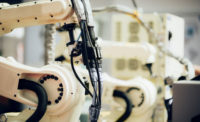From the NIOSH Director’s desk
The human face of artificial intelligence

The term artificial intelligence, usually referred to as AI, first came into use in the 1956, when computer scientists began to predict that machines had the potential to be programmed to “think” and learn from experience, just like human beings. It was in the 2010s that AI became more of a reality, thanks to the availability of practically unlimited storage capacity on computers, along with faster, cheaper processing power, and a flood of big data.
Recently, many articles have been published in the popular press about various uses of AI in areas such as robotics, healthcare (e.g., to identify lung cancer from x-ray images), visual and speech recognition, and text translation.
In addition, the U.S. government’s interest in understanding the benefits and risks of AI has also increased, as highlighted in a 2018 White House Summitpdf iconexternal icon report. Recently, NIOSH established its own Artificial Intelligence Interest Group (AIIG) which held its inaugural meeting in May 2019. Through AIIG, NIOSH is bringing together individuals from across NIOSH to share information about how AI is being used, what successes and pitfalls come from using AI, and what new ways AI may be applied to solve problems relevant to the NIOSH mission.
Many researchers in NIOSH are already using AI. Some examples include
- Using AI to analyze genomics information. The system is able to examine over 22,000 genes looking for suitable biomarkers.
- Exploring AI image analysis and computer vision for self-driving vehicles.
- Using AI for “natural language processing” leading to coding of health records and using AI in analyzing health informatics data.
- Using AI for NIOSH Industry & Occupation Computerized Coding System (NIOCCS) to change text descriptions of industry and occupation into standard codes. Also using AI to work with data from kinetic sensors and video recorder input to study human factors.
Moving forward, AIIG will explore ethical issues, psychological effects, such as those from AI-caused job displacement, and the reliability of AI, as well as the implications on worker and workplace safety. AIIG is also developing a NIOSH webpage on AI to highlight on-going activities.
The advances in AI present new opportunities for progress across occupational safety and health. However, with that comes a need to understand the potential implications of AI on workers and workplaces in unanticipated ways. NIOSH is committed to leveraging the benefits of AI to improve our ability to respond to the modern world of work, while also working to ensure that the safety and health of all workers continues to be protected.
Looking for a reprint of this article?
From high-res PDFs to custom plaques, order your copy today!








